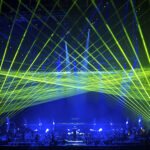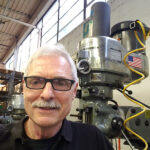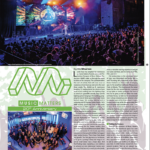
Family Business Survives and Thrives “Making Magic Every Day”
“I liked making magic happen every day,” says George Studnicky. And because of his business savvy, the ability to navigate an ever-changing market and the backing and support of his family and team of associations, there’s been many days of magic making as Studnicky’s Creative Stage Lighting (CSL, creativestagelighting.com) celebrates its 40th year in business this year.
“We’re a small business who grew into a national distributor, supplier and rental source,” explains Dan Studnicky, marketing director. Today they serve markets in moving lights, control consoles, conventional lighting, cable and custom cable, power distribution systems, custom cases, effects and consumables. Their rental division supports anything happening on a stage or studio. Perhaps their most important contribution to the industry is their proprietary Dura-Flex line of cables, which, Studnicky notes, were among the first to meet the EU’s stringent RoHS standards. Their list of tour rental clients is also impressive: the Ramones for over 20 years, Meat Loaf for 15 and Spyro Gyra for five. Others include Eddie Money, Joe Jackson, Celtic Woman, Jackson Brown, Maroon 5, Phish, Julio Iglesias and Natalie Cole. Heck, they were even part of whatever was going down at Studio 54 in New York in its heyday.
But it all started humbly enough ….

Library U
George B. Studnicky III was born in Newark (“I’m a Jersey boy”) and spent most of his childhood in Florham Park. “I was a frustrated high school drummer who made more noise than music,” he confesses. In high school, he earned his FCC license and engineered and DJ’d at his school’s FM radio station. He later attended the County College of Morris and the Cleveland Institute of Electronics, where he studied electrical engineering. Along the way, he built his own stereos and color organs. He snatched a job at Entertainment Systems Corporation and worked bars and live events, first as a spot operator, then handling tech before moving over to their sales department.
A methodical, calculating man not prone to whims, Studnicky did not take the decision to open his own business lightly, and he became a dutiful student at Library U.
“I checked out every book on lighting theory,” he explains. “I was fascinated by the dimensional capabilities of live lighting and learned how to create textures.” His library card also came in handy for just about every book on business administration and management that he could get his hands on. That preparation served as a good entrepreneurial foundation, and in 1977, Studnicky hung out the CSL shingle in Mount Arlington, NJ. It was a strategic location right off I-80, which bands used to get into Manhattan.
Studnicky reminds us that, back in those days, those who lit bands typically owned enough gear to rival the inventories of regional lighting companies. “We were the Starbucks of lighting back then,” he recalls. “On Mondays, a certain genre of LDs shopped, and then on Tuesday, the heavy metal guys would show up. I just eavesdropped on their conversations and learned a lot.” George’s wife, Lily, is also his business partner. She was a schoolteacher in the early days and was eventually recruited as the bookkeeper. Later on, she managed their move into computerization, and today, Lily handles payables and keeps the shop looking great.
CSL’s bigger clients in the early days included the cast of Beatlemania, Harry Chapin, Doug Henning and Paul Anka, among others. Also during those days there was a healthy middle market of working college concerts and student activities. “We’d sometimes do a dozen shows over a single weekend. Then when Reagan became president, the subsidies for student
activities were wiped out, and overnight that market vaporized. About a third of the sound and lighting companies around went out of business.” CSL survived in part by being in the mail order business.
But the company also grew with the touring business. Touring back then was typically limited to a region. “I would go out for two or three weeks with folks like David Bromberg, Rick Derringer and Pat Benatar, working the Northeast region,” he says. “There was really something great about being part of a strong organization and having everything so well-orchestrated. You knew exactly what time load-in was, what order things went in and up, what time you were to have your coffee, and everything you were responsible for you could see with your eyeballs.” He also misses the personal aspect. “You grew strong friendships with sound company staff, the artists, the venue crew. Some of that has evaporated in our industry. In many instances, technicians are lighting mercenaries, going to work only where the money is!”
In 1982 the Studnickys had twins, Dan and George IV. Dan laughs and tells of working for his dad at eight years old, recycling garbage. Then, later, “when he was teaching us how to drive, we’d often take weekend trips to the office. We were pretty much his chauffeur to his desk!” Today, Dan manages CSL’s marketing efforts and other day-to-day needs. George IV has his own company, Revolution Lighting.
Diversifying Before It Was Cool
One of the reasons CSL survived during the early 1980s is they started diversifying before diversifying was cool and even became a manufacturer. “We didn’t necessarily plan that, but we started making things that we used, like road cases. Then a client would see them and go, ‘Where did you get that?’ And suddenly, we were road case manufacturers.”
Some of what they have done over the years has been pioneering. Back in the day, lighting consoles laid flat and were all metal. CSL would pull off the sheet metal side panels and put cherry wood sides that sloped and even added the soon ubiquitous padded armrest. Then they created a custom case for it. Creating their more road-worthy EPS power distribution systems was another innovation. Released in 1998, their Dura-Flex cable products were the first to eliminate talc as a slipping agent, the first to go lead-free, the first to comply with REACH (another stringent EU standard) and the first to have a UL Listing. Another smart move was to supply clients with their need for miscellaneous lighting items including bulbs, gels and the like. Along the way George got Sylvania to manufacture a 600W Par64 for them and got Hubbell to make their connectors all black, as opposed to black and white.
In 1994, they expanded for a third time, moving to their current location, a 33,000 square foot facility in North Creek, NY, in the Adirondacks. “Everyone was involved in the design and ergonomics,” George says, noting that, before the move, “everyone was stretched to the max, dealing with less-than-ideal work conditions. Once we moved into the new facilities, we all felt like this was heaven. Everyone had been starved, and once allowed access to much greater capabilities, we all simply took off like a rocket just being released.” Business continued to hum until 2009 when it exploded again, and it was their best year yet. It was a big year for hiring, too. “Every initiative we did panned out very well for us,” George says.
Today, most CSL’s business is sales, both their own products (particularly their Dura-Flex cables) and others they distribute. Rentals account for around 15 percent of their business, and they still do some regional work for certain artists and corporate clients by request.

Looking Back, and Forward
In the late 1970s, George brought lights into the Philadelphia Academy of Music for a special concert for the Four Tops and The Temptations. “Turned out they had no LD that night so ‘tag,’ I was it,” he says. “After a conversation with their manager about why he didn’t want to see green on stage, I put a quick plot together and got the crew to load color.” Midway through the first set, the manager came out and told him he had soul. “What a great compliment and feeling that was!”
Those who know Studnicky know he has many other stories, including making a pyrotechnic birthday cake for Bill Cronheim, president of Entertainment Systems; to causing the N.J. State Police to come to the shop to investigate a UFO sighting triggered by their Super Trouper Operator class one evening. “Once I had a loaded 38 pointed at me upon accidentally walking into a box office receipts room, and another time I watched a promoter chain saw a wall out of a Long Island club to expand the stage so the [punk band] Plasmatics could fit on it.”
When his kids were young, they were drawn to the theater. Dan landed the lead in Joseph and the Amazing Technicolor Dreamcoat, and brother George IV designed and directed the lighting. (“People couldn’t believe it was a high school production,” beams proud dad.) Each summer since 2000, CSL has sponsored a four-week workshop program in Lake George, NY called Youtheatre, which mounts three Broadway shows. CSL has supported the effort by underwriting the royalties cost of the productions. They have given back to the industry and their community too, supporting Hudson Headwaters Health Network, Behind the Scenes and Dollars for Scholars, among others.
Looking at the next 40 years, Studnicky says they want to look for more ways to involve everyone at the company on a higher level. “I believe that everyone here has opinions that matter,” he says. “We’ve always invited people to share opinions and beliefs.” Otherwise they will continue with their winning formula. “While knowing the requirements of and how to formally sell from years in sales management, the early days of CSL were more about sales being a side effect of a good conversation with clients and customers,” he adds. “It’s all about relationships and listening, then presenting solutions for what [the client] wants to accomplish. We still carry on this tradition of selling.”


